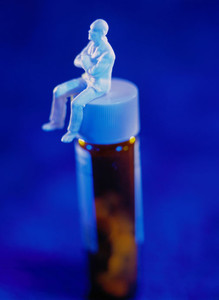First developed in the 1980s, low molecular weight heparins (LMWHs) are complex anticoagulants derived from porcine intestinal mucosa and are used in the treatment of deep vein thrombosis and pulmonary embolism. Heparin sodium’s anticoagulant activity is mainly governed by its ability to bind to the serine protease inhibitor antithrombin (AT). In this sense, heparin sodium functions as a cofactor for AT by modifying its conformation, thereby accelerating the inactivation of clotting factors.
Enoxaparin sodium, a LMWH developed by Sanofi, has seen widespread use in the US since 1993, and since that time, generic LMWHs, including from Sandoz and Amphastar, have been developed. There is, however, ongoing scientific research with regards to the structural identity between generic LMWHs and their originators. As Mourier and co-authors illustrate, ‘there is still much to learn about the differences between originator and generic LMWHs’ [1].
By definition, a generic medicine should be identical to its originator medicine and different manufacturers should be able to produce the same product. Current advances in analytical and separation methods have enabled researchers to isolate and sequence many of the active process-dependent components of enoxaparin. However, researchers have not yet been able to fully characterize all the components of enoxaparin. Traditional analysis methods, such as high-performance liquid chromatography (HPLC) separation, are not suitable to resolve mixtures above tetradecasaccharides and therefore cannot be used alone for comparison studies of enoxaparins. Other tests used for quality assurance of LMWHs are not designed to make such comparisons, as they also lack the necessary resolution for the proper characterization of polysaccharide components [2, 3].
Recently, Mourier and co-authors developed a protocol to analyse differences between several batches of originator and generic formulations of enoxaparin. This protocol included analysis methods such as AT binding chromatography, CTA-SAX chromatography, disaccharide building block quantification, nuclear magnetic resonance (NMR), and the combination of orthogonal separation techniques.
The results of this research showed that it was possible to distinguish between the three different manufacturers of LMWHs (Sanofi, Amphastar and Sandoz), based on the CTA-SAX chromatography oligosaccharide and polysaccharide fingerprint of their respective LMWH. After enzymatic digestion, SAX chromatography techniques served to highlight compositional differences in di- and tetra-saccharide building blocks, which showed that Amphastar enoxaparin had a significantly higher degree of sulphation and lower glycoserine derivative content compared with both Sanofi and Sandoz enoxaparins. Differences between Sanofi and Sandoz enoxaparins, albeit significantly smaller than between Sanofi and Amphastar enoxaparins, were also observed following quantitative building block statistical analysis of these two LWMHs. Those differences were further verified using NMR techniques examining the compositional oligosaccharide differences in both the low- and high-affinity AT fractions of enoxaparin.
The authors show that it is possible to analytically differentiate generic LMWHs from the originator LMWH. The observed structural differences were more pronounced than would have been any batch-to-batch variations that may occur during the manufacturing process. The clinical implications of these differences, and their significance, would require further scientific examination and research.
Conflict of interest
The authors of the research paper [1] reported the following conflicts of interest: P Mourier, C Agut, F Herman and C Viskov are employees of Sanofi. H Souaifi-Amara is a Sanofi external consultant from Experis IT, Life Sciences, Nanterre, France.
Abstracted by Pierre Mourier, Sanofi, France.
Editor's comment
Readers interested to learn more about LMWHs are invited to visit www.gabi-journal.net to view the following manuscript published in GaBI Journal:
Differences in pharmacokinetic behaviour of branded enoxaparin and a US generic version in a non-human primate model
If you are interested in contributing a research article in a similar area to the GaBI Journal, please send us your submission here.
Related articles
Canada clarifies regulatory pathway for subsequent entry low molecular weight heparins
EU guidelines for biosimilars
References
1. Mourier PA, Agut C, Souaifi-Amara H, Herman F, Viskov C. Analytical and statistical comparability of generic enoxaparins from the US market with the originator product. J Pharm Biomed Anal. 2015;115:431-2.
2. Mourier PA, Guichard OY, Herman F, Viskov C. Isolation of a pure octadecasaccharide with antithrombin activity from an ultra-low-molecular-weight heparin. Anal Biochem. 2014;453:7-15.
3. Ye H, Toby TK, Sommers CD, Ghasriani H, Trehy ML, Ye W, Kolinski RE, et al. Characterization of currently marketed heparin products: key tests for LMWH quality assurance. J Pharm Biomed Anal. 2013; 85:99-107.
Permission granted to reproduce for personal and non-commercial use only. All other reproduction, copy or reprinting of all or part of any ‘Content’ found on this website is strictly prohibited without the prior consent of the publisher. Contact the publisher to obtain permission before redistributing.
Copyright – Unless otherwise stated all contents of this website are © 2015 Pro Pharma Communications International. All Rights Reserved.








 0
0











Post your comment